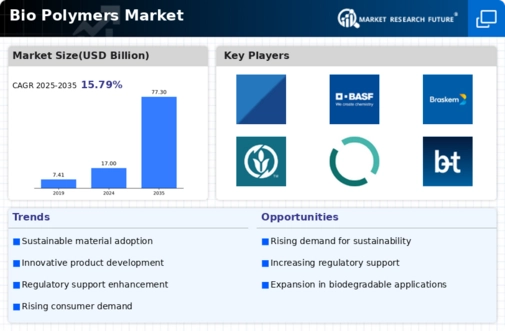Top Industry Leaders in the Bio Polymers Market
 The biopolymers market, encompassing biodegradable and bio-based polymers, is experiencing a surge in demand driven by environmental concerns, growing consumer awareness, and favorable government policies. This rapidly evolving landscape boasts a diverse roster of players vying for market share, employing various strategies to navigate the promising yet challenging terrain. Here, we delve into the intricate dynamics of this green arena, exploring key insights:
The biopolymers market, encompassing biodegradable and bio-based polymers, is experiencing a surge in demand driven by environmental concerns, growing consumer awareness, and favorable government policies. This rapidly evolving landscape boasts a diverse roster of players vying for market share, employing various strategies to navigate the promising yet challenging terrain. Here, we delve into the intricate dynamics of this green arena, exploring key insights:
Strategies Shaping the Battlefield:
-
Innovation Powerhouse: Leading players like NatureWorks, Evonik, and BASF are investing heavily in R&D, aiming to expand their product portfolios with high-performance biopolymers tailored for specific applications. Examples include NatureWorks' Ingeo PLA for food packaging and Evonik's VESTA bio-based polyamides for automotive interiors.
-
Vertical Integration Play: Companies like Total Corbion and Braskem are adopting vertical integration strategies, securing feedstock control and streamlining production processes. This enhances cost-efficiency and quality control, providing a competitive edge.
-
Sustainability Alliances: Collaborations across the entire value chain are becoming increasingly common. Partnerships between biopolymer manufacturers, packaging companies, and brands are fostering innovation and accelerating market adoption. For instance, Danone partnered with Evonik to develop innovative yogurt cups using VESTA bio-based material.
-
Acquisition Buzz: Mergers and acquisitions are another key strategy, enabling companies to expand their geographic reach, acquire new technologies, and diversify their product offerings. Recent example includes Eastman Chemical's acquisition of TMV Polymers, strengthening its bio-based polyethylene terephthalate (PET) capabilities.
-
Cost Reduction Focus: Despite growing demand, high production costs remain a challenge. Companies are actively pursuing cost-optimization strategies, including scaling up production, utilizing biomass waste as feedstock, and optimizing fermentation processes.
Factors Dictating Market Dominance:
-
Product Performance: Biopolymers need to compete with established petroleum-based alternatives. Offering comparable performance in terms of strength, durability, and barrier properties is crucial for wider adoption.
-
Price Competitiveness: Bridging the cost gap between biopolymers and conventional plastics is essential for mass market penetration. Technological advancements and economies of scale will play a pivotal role.
-
Application Diversification: Moving beyond niche applications like packaging into high-value segments like textiles, electronics, and automotive will drive market growth.
-
Regulatory Landscape: Favorable government policies supporting sustainability initiatives and bio-based products will accelerate market adoption. Recent examples include the EU's Single-Use Plastics Directive and California's SB 1243 legislation.
-
Consumer Sentiment: Growing consumer awareness and preference for sustainable products are propelling the biopolymers market. Eco-conscious brands are leveraging biopolymers to differentiate themselves and cater to evolving consumer demands.
Key Players
- Novamont
- BASF
- Braskem
- NatureWorks
- Biome Bioplastics
- Mitsubishi Chemical Holding Corporation
- Biotec
- Toray Industries
- Plantic Technologies
- TotalEngies Corbion
Recent Developments :
August 2023: Evonik expands VESTA bio-based PA production capacity in Germany to meet increasing demand.
September 2023: Braskem partners with Mitsubishi Chemical to develop and commercialize bio-based polyolefins in Japan.
October 2023: Total Corbion announces a new PLA production facility in Thailand, targeting the Southeast Asian market.
November 2023: NatureWorks unveils a new range of Ingeo PLA grades with enhanced heat resistance for automotive applications.
December 2023: The European Commission adopts a new regulation setting minimum recycled content requirements for plastic packaging, further boosting demand for biopolymers.
